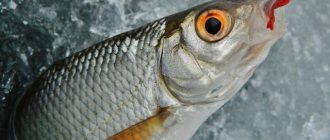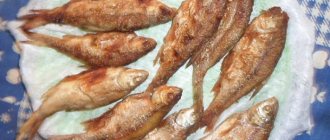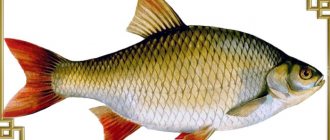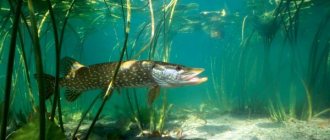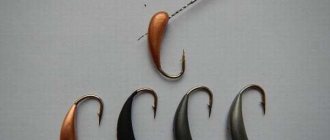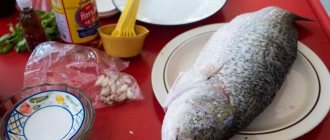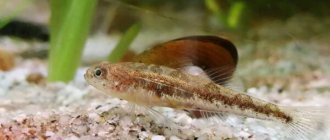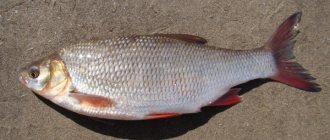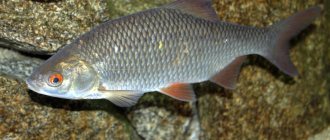- Wild animals
- >>
- Fish
A fish like roach is familiar to many. It is popular and often found in various bodies of water. Fishermen claim that roach can be caught all year round, and skillful housewives prepare a huge variety of dishes from it. Almost everyone knows what this silver fish looks like externally, but not everyone knows about its habits, character, and nuances of the spawning period. Let us understand the peculiarities of the life activity of this fish, characterizing it from various aspects.
How to recognize a fish?
This unpretentious fish is widely distributed in water bodies all over the world, is undemanding when it comes to food, and easily switches from one type of food to another. In Russia, such species diversity is not observed; water bodies are inhabited by the common roach and its two subspecies - roach and ram.
The roach has an elongated body; its shape is somewhat reminiscent of a herring. Her back is painted black, which has a greenish or bluish tint, and her sides and belly are silver. Before spawning, some fish become covered with small whitish spots. Over time, they become dark and harden, so the scales feel rough to the touch. In size, the silver scales are large and tightly pressed to each other.
The color depends on the age and nature of the reservoir. Sometimes there are specimens with rather bright golden-colored scales, and their back and sides have a more reddish tint.
The small mouth of the roach is located at the end of the blunt snout. The pharyngeal teeth are unserrated, single-row. The forked caudal and dorsal fin are gray-green, the remaining fins (ventral, pectoral and anal) are red-orange. This is how roach is colored. Other subspecies differ not only in the shape of the body, but also in color.
A characteristic feature of the roach, by which it is distinguished from numerous representatives of the carp family, is the color of the iris - it is orange with a blood-red spot on its upper part.
If we talk about size, namely the length of the body, then the semi-anadromous roach has the greatest length - up to 50 cm, the residential roach, which is constantly in fresh water, is inferior in size and grows on average up to 30 cm.
Description
Roach has many subspecies, some of which have their own names: roach, ram, soroga... In the Urals and Western Siberia, this fish is called “chebak”.
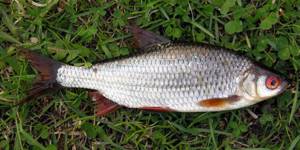
The roach has a blackish back with a blue or green tint, and a silver belly and sides. It differs from the closest species in having pharyngeal, non-serrated teeth arranged in a row on each side, fairly large scales, a mouth located at the end of the snout, and a dorsal fin located above the base of the ventral fins.
The scales are silvery-white, and the fins are orange-red, with the exception of the dorsal and tail.
Classification
Numerous subspecies are divided into freshwater representatives that never leave rivers and reservoirs with fresh water, they are called resident fish, and those who prefer to live in brackish water.
Freshwater subspecies:
- Common roach. The fish is small in size, barely reaching 30 cm. It lives in the Caspian and Azov seas, in Lake Chebakule.
- Chebak or Siberian roach is a commercial fish that is caught on an industrial scale. It differs from other species in its rapid growth and reproduction. Its habitat is fresh water bodies of the Urals and Siberia.
Non-freshwater species:
- The Aral roach is a schooling fish found in the basins of the Amu Darya and Syr Darya rivers. The size reaches 40 cm, the maximum weight is 1200 g.
- The Caspian roach is a commercial fish that lives in the Caspian Sea and goes to the waters of the Volga for spawning and wintering. It can be distinguished from roach by its dark gray fins with a black border. It grows up to 30 cm, weight - 1500 g.
- The Azov-Black Sea ram is also a commercial semi-anadromous fish that lives in the Azov and Black Seas. It goes into river waters to spawn. On average it grows up to 35 cm, but there are specimens 50 cm long and weighing 2 kg. The fish is larger than the common roach and has thicker teeth.
| Average length, cm | Average weight, kg | Number of scales in the lateral line, pcs. | |
| Common roach | 50 | 1,5 | 40-45 |
| Chebak | 35 | 0,9 | 40-45 |
| Taran | 25-30 | 2 | 48-52 |
| Vobla | 30 | 1,5 | 41-48 |
Gear selection
It is recommended to catch roach using a float rod with a jig. The line should have a length 20 cm shorter than the rod, which should preferably be equipped with a shock absorber - a 50 mm long rubber band that smooths out jerks and prevents the fish from breaking the line.
The tackle must be equipped with at least three weights, with the smallest one located at the bottom. In winter, the roach often lifts the bait, but it should not feel the weight of the sinker.
In mid-April and early May, fish swim in schools along the coastal vegetation, eating everything that comes along the way. During this period, you can catch roach from the shore using a fishing rod with a rod no more than five meters long, choosing maggots, bloodworms, dough, bread, a worm or anything else as bait.
During spawning, the fish is not afraid of anything at all, and you can literally catch it with your hands. Large pikes and perches follow the roach; they devour the stunned fish, not even paying attention to the predators.
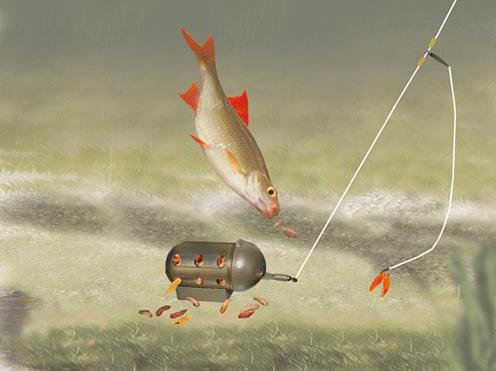
It is ineffective to catch cyprinids using a spinning rod, but this does not mean that there will be no catch at all. In this case, it is necessary to place a No. 4 or No. 5 hook with a worm or maggot attached in front of the rotating spoon. Fishing should be done with slow retrieval at a depth of about one and a half meters.
Habitat
Roach prefers rivers without stormy currents; it likes quiet backwaters with rich vegetation. A sandy bottom and warm water are all it needs for normal life.
It hides from predators in reeds and cattails, and in hot weather it moves into the shade of flooded bushes and tree trunks. It is found in small ponds, rivers and rivulets, lakes. Numerous schools of roach are found in the basins of the Black, Caspian and Azov seas.
The fish prefers to swim at the bottom of the reservoir, but is forced to rise to the middle layers of water for food. In the hot season, it swims near the water surface, where it feasts on insects that have carelessly fallen into the water.
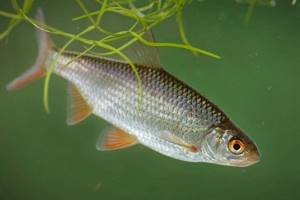
General information about the track
In Siberia, this fish has a completely different name, where it is known as chebak. It has several names - chebak, roach, roach, soroga.
The population of this fish is the largest in all of Europe. There are several types, but their appearance is practically the same. There are differences only in habitat, behavioral characteristics and slight differences in appearance.
It grows quite slowly, for example, in order to reach a weight of 300 g it will take 10 years. You can find individuals weighing 1.5 kg and a body length of 30 cm. But it is very rare.
What does a track look like?
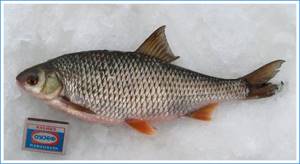
The appearance of the roach is known to every self-respecting fisherman; only those who have never been fishing can fail to recognize this remarkable individual. The back of the collar is slightly darker than the body, with tints of blue or green. It has a small red fin.
The entire body is covered with small silvery scales, which are very easy to clean off. The pelvic and anal fins are bright red, which is a distinctive feature of this species. The eyes have a red rim.
Habitat
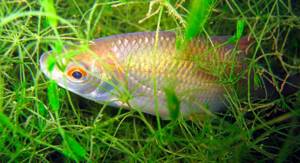
This fish is found throughout Europe. It can be caught in reservoirs of Siberia, in the basin of the Caspian and Aral seas.
It is very easy to find, because roach lives in large rivers, and even in small ponds and lakes. But, in order to catch it, you need to know the specific place where she spends her time.
To detect it, you just need to carefully examine the body of water in search of algae thickets in a place with a weak current. It can be found near trees or where it can find a lot of food.
First of all, you need to look for a path in lakes or rivers into which small streams flow or in those reservoirs on the banks of which there are many trees, especially willows. There are a lot of such places throughout Russia; you won’t have any difficulties finding them.
It is very important that the current in the reservoir is calm and slow. It can also be found in bodies of water without a current. You can find roach near flooded snags, in which it looks for food.
Sorogi fish nutrition
This fish eats almost everything. The main diet consists of insects, which she catches when they land on the water or fall from a tree:
- Mosquitoes
- Midges
- Grasshoppers
- flies
- Caterpillars
- Insect larvae
She also likes to eat aquatic crustaceans. He also does not disdain plant foods; he eats seeds, plants, cake, and algae. The choice of bait for fishing is very simple; you can take worms or bloodworms, or catch a caddisfly in the river.
Fishing

Previously, when only valuable species of fish were important in fishing, if a fish was caught in a net, it was simply thrown away, so it died in huge quantities. Over time, this fish began to be appreciated, especially when the fishing industry began to actively develop. Even large industrialists caught it; it was harvested in huge quantities, several million kilograms.
For sale, it was smoked, dried and dried. Roach was very popular, because its price was low and the meat was very tasty. The smoked carcass was a little more expensive, the salted carcass was much cheaper.
Interesting facts about roach
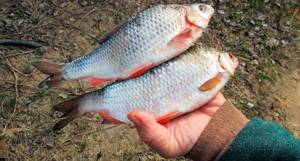
Some pretty fun facts about this fish:
- The track is so common all over the world that in many countries its image can even be seen on postage stamps.
- It is best to look for it in fresh rivers with a lot of algae. Usually specimens weighing 100-400 g are caught, but specimens weighing 2 kg have been caught several times in the lakes of the Urals.
- It is often confused with the rudd. But the most important distinguishing feature is the roach’s eyes; they have a bright red rim.
- The best time for fishing is when the reservoirs are covered with the first ice, and when it begins to melt at the end of winter.
- The track grows very slowly, ten-year-old individuals weigh only 300 g.
Lifestyle
Roach cannot be found alone; this fish gathers in schools, which usually contain individuals of the same size. Small fish stay closer to land; adult roach prefer depth.
At the beginning of spring, all fish living in stagnant water rush to shallow water with warm water, since here they warm up faster under the sun's rays, and prepare for spawning.
In summer, when hot weather sets in, large fish leave shallow rivers and migrate to deeper places.
In the cold months, the entire flock swims to the depths for the winter to protect itself from frost. She hides under snags and vegetation.
Fishing methods and necessary equipment
The most common way to catch roach is with a regular float rod. It can be caught with a float rod even during prohibited fishing periods, except for certain prohibited fishing areas, which are specified in the Fishing Rules.
Large roach can be caught using feeder and bottom gear. You can read about catching and searching for large roach in the article: How to catch large roach in summer.
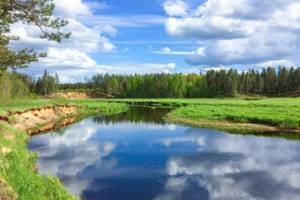
Roach habitats
Spawning
A two-year-old roach (this is how long it takes for a fish to reach puberty from birth) begins to lay eggs in the second half of April, when the water heats up to +8 °C. In this case, the water should subside after being freed from ice. A couple of weeks before spawning, the fish “dresses” in its nuptial plumage; as mentioned above, white spots appear on its body. However, they disappear a week after spawning.
Roaches arrive in large flocks to spawn. Therefore, this process is accompanied by noise; you can clearly hear the fish splashing and playing, especially if it lays eggs in the lake. The fish, as if on command, jump out of the water, soaring upward, and then splash on the water surface, the rest cut small circles or describe zigzags in a rather strange “pose” - belly up or on their sides.
The large number of fish gives the impression that they are “rubbing” against each other and the water surface. Such spawning allows for a high degree of fertilization of eggs, with female roach laying up to 100 thousand eggs. In rivers, spawning is not so noisy, but it is also noticeable and longer due to the cold water. When it gets colder, spawning can last up to 3 weeks.
In order to lay eggs, semi-anadromous subspecies first need to ascend the river to the lower reaches of fresh water. Females lay eggs at a time, sweeping from 10 thousand to 202 thousand eggs, which have a greenish tint. The caviar is soft, transparent and sticky. For this reason, it easily sticks to blades of grass or moss. After spawning, the spawned fish returns to the sea again.
After 7-14 days, juveniles emerge from the eggs. By mid-May, nimble schools of fry rush around the surface of the water. They hide from predatory fish, including their larger relatives, in the grass and reeds. At first, they feed from their yolk sac - this is an outgrowth of the intestine, inside which there is a supply of yolk, but the time comes when it is empty, and the fry have to look for new food - small plankton. Grown-up juveniles gradually switch to crustaceans and plants. In July, the young leave their shelter and swim out into open water, finally settling there by the end of August.
Social structure and reproduction

Photo: Little roach
Sexual maturity in males and females of roaches occurs at different times; in males it comes at the age of two to four years, in females - from four to five. The spawning period occurs at the end of April and lasts throughout May. For reproduction, roaches choose places where there are underwater thickets; creeks, shallow waters, flooded meadows, and bottom areas of rivers with rapid currents are also suitable for this process. During the mating season, roaches can be seen jumping out of the water, creating splashes. Males try to follow females everywhere.
When the water warms up to 10 degrees plus, the males’ clothing acquires a roughness, which is created by light tubercles appearing on the body. In schools, females spend about two weeks touching such rough sides of males, which prompts them to lay eggs that have a pale yellowish color. One female can have from 10 to 200 thousand of them, the diameter of the eggs varies from one to one and a half millimeters. In bodies of water where there is no current, the eggs stick to weeds, reeds, and the roots of coastal trees. They are held in current waters by willow moss and stones.
The incubation period ranges from 4 to 12 days; when born, the fry have a length of 4 to 6 mm. Babies up to one month of age are in the bottom thickets, feeding and hiding from predatory ill-wishers. Fry are better suited to waters where the current is completely sluggish or absent (pond, swamp). Young fish prefer shallow water areas, and their growth rate is quite slow. The average lifespan of a roach is about 20 years, during which considerable period it usually reaches a length of forty centimeters.
Interesting fact: In rivers near power plants, the spawning period of roach can take place even in January, this is explained by the presence of warm wastewater.
Roach fishing
Residential roach is not only a commercial fish, which is often used for the production of cat food and added to animal feed, but it is also used for sport fishing. When catching it, the angler demonstrates his skill, and it is also a bait for catching larger predator fish - pike perch, pike, catfish. Roaches are caught almost all year round; they are not caught on a hook only during periods of severe frost - in December and January.
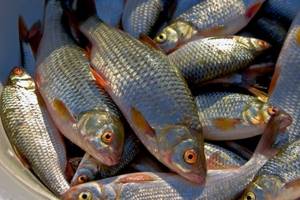
Best period for fishing:
- May - second half of the day, the water warms up well by this time;
- summer dawns;
- a week before spawning - the roach begins to eat, it loses vigilance and is less picky about the bait;
- along the first and last ice.
Features of fishing at different times of the year
In the spring, as soon as the reservoirs are free of ice, roaches populate the shallow waters. For fishing, take a fishing rod equipped with a thin fishing line, a light float and a small hook. The bait chosen is bloodworms, dung worms, dough or maggots, which are sent downstream or lowered to the bottom of the reservoir, depending on the chosen gear.
Breadcrumbs and rolled oats are used as complementary foods. During spawning, roach fishing is prohibited in most water bodies. During this period, the fish is not afraid of anything to such an extent that it practically “jumps into your hands.”
In the summer, with the onset of heat, only small fish are found near land. The bite is very capricious. A well-fed roach is not interested in bait. To catch it, choose a shortened rod with a hook number 16-20 with a thin leash. For bait they take maggots, bloodworms or caddisfly larvae, but grasshoppers, bark beetles and silkworms (water buttercups) are more tempting for roaches.
In autumn the bite picks up. During this period, it is better to choose shallow reservoirs for fishing, but with a large area. To interest the fish, an earthworm or a bunch of maggots is placed on the hook. In October–November, at the first noticeable cold snap, the fish gather in schools and go into the depths for the winter.
In winter, fish are attracted by bloodworms, burdock moths and caught with jigs. The line chosen is thin - 0.1-0.12 mm.
Which gear to choose?
Both donkey and float gear are suitable for fishing. You will need a thin line up to 0.15 mm, a float even less up to 0.1 mm. The hooks are selected small. If the bite is bad, use a yellow hook, as it is less noticeable. The float should be light and have a camouflage color so as not to scare the fish, since they are usually caught at shallow depths or near the surface.
For summer fishing, gear is prepared that is more inconspicuous and sensitive; thinner fishing line and hook are chosen. During this period, the roach does not experience problems with food, so it becomes picky and timid. The bait is placed so as to completely hide the sting of the hook.
How do fish bite?
Roach is a cautious and intelligent fish. Her bite is fast and sharp, often the fisherman does not have time to notice how she managed to pull the bait off the hook. Large roach have a bolder bite, and an attentive angler will not miss his chance to hook it. Small fish can really fray your nerves; sometimes you get the feeling that the fish is simply mocking the would-be fisherman. But this is far from true. The roach, like any living creature, wants to live, it senses danger and acts very carefully.
Cooking recipes
Many fishermen successfully catch this fish, but few of them know how to cook roach? By and large, they don’t need this, because the wives do the cooking. Here are some interesting recipes.
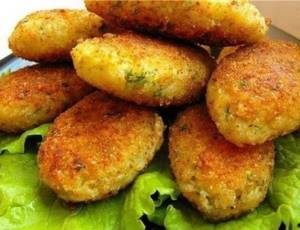
The simplest dish is roach cutlets. Since this fish is small, it is not at all necessary to remove bones from it; it is enough to remove the entrails, wash it, and cut off the head and fins. The carcasses prepared in this way are passed through a meat grinder several times, after which a little lard (1:6), a couple of slices of a soaked loaf, an egg, chopped onion and garlic, ground pepper, and salt are added to the resulting minced meat. The amount of the last four ingredients is to taste. Cooking consists of three stages. First, you need to form cutlets from the minced meat, then roll the pieces in breadcrumbs and fry on both sides over low heat using vegetable oil. Each side takes approximately 4-5 minutes. When the roach cutlets acquire a golden crust, they can be removed.
Another fish delicacy is dried roach, especially if it contains caviar. To do this, take fish weighing up to 0.5 kg. In the spring, you don’t have to gut it, since there is no greenery in the stomach at this time of year, which gives a bitter taste. The fish, washed from mucus, is first salted in an enamel container, generously sprinkling each row of carcasses with coarse salt. To make them better salted, place a plate on top, and place a heavy load (a brick or a jar of water) on it. After 2 days of salting, the fish is soaked in cold water for 2-3 hours. When the fish starts to float, it means it’s time to take it out of the water and prepare it for drying, namely, dip it in a solution of 3 percent vinegar, the purpose of which is to repel flies. Roach is dried in the open air at a temperature of 18-20 degrees. Depending on its size, this may take from 1 to 4 weeks. After this, it should “ripen” for the same amount of time in a fabric bag in a cool room.
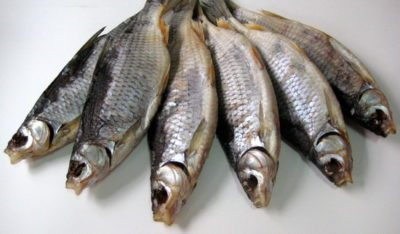
Roach baked on coals turns out to be very tasty. As they say, in nature and with smoke. You can cook it this way right on the banks of a river or lake. To do this, the fish is cleaned, the gills are removed, washed and cut into portions. Rub each piece with salt and pepper, add a little butter and wrap it in foil. In this form, they are buried in hot ashes so that the smoldering coals are on top. Half an hour of tedious waiting, and the dish is ready! The “smoky” fish can be decorated with herbs, and the best side dish for it is considered to be jacket potatoes baked in the same way.
Video on the topic:
Catching roach with a fishing rod in spring. Large roach on a float in April
14:47
How to properly dry fish. How to deliciously dry roach. The easiest way
15:06
Fishing in the spring on a small river. Catching roach a meter from the shore
12:49
Roach cutlets
09:32
narybalke
Growing roaches
Roaches are not artificially bred on an industrial scale. Usually it is grown in parallel with other carp representatives in order to get rid of excess vegetation in the pond.

You can place it in your own pond, providing it with the necessary living conditions. The roach’s “appetite” depends on the water temperature and the season of the year. The optimal water temperature is +18…+24 °C. When it cools, the feeding intensity decreases; in winter, it practically does not require food. It should be remembered that roaches eat a lot of zooplankton, the food of which is algae, so the pond can quickly bloom.
So, although roach is a low-value fish, catching it brings pleasure to anglers. Properly selected places, gear and bait are part of successful fishing. Observation and attention are another component that depends only on the fisherman.
0
0
Copy link
